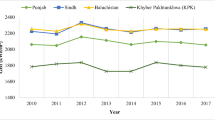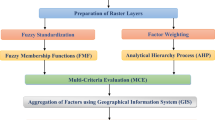Abstract
The remarkable increase in population and industrial development has brought priority to the installation of solar power plants in developing countries. Solar power site selection is a complicated task, which involves spatial assessment, driving environment, economic and climatological factors. For different site selection studies, multi-criteria estimation was used. This study utilized GIS and Boolean-AHP model to perform solar power site selection in Erbil governorate. The study proposed three scenarios: economic weight scenario, environment weight scenario and equal weight scenario. The final index model identifies four groups: unsuitable, low suitable, moderately suitable and highly suitable. Consequently, the study identified 369 candidate sites to install the solar power farms, interestingly; about 85% of the candidate sites are located in the southern and central part of the study area.






Similar content being viewed by others
References
Abed, F. M., Al-Douri, Y., & Al-Shahery, G. M. Y. (2014). Review on the energy and renewable energy status in Iraq: The outlooks. Renewable and Sustainable Energy Reviews, 39, 816–827.
Al Garni, H. Z., & Awasthi, A. (2017). Solar PV power plant site selection using a GIS-AHP based approach with application in Saudi Arabia. Applied Energy, 206(July), 1225–1240.
Alamdari, P., Nematollahi, O., & Alemrajabi, A. A. (2013). Solar energy potentials in Iran: A review. Renewable and Sustainable Energy Reviews, 21, 778–788.
Al-Din, S., Kuzovic, D., & Iranfar, M. (2017). Renewable energy strategies to overcome power shortage in Kurdistan Region of Iraq. Industrija, 45(2), 7–21.
Al-Kayiem, H., & Mohammad, S. (2019). Potential of renewable energy resources with an emphasis on solar power in Iraq: An outlook. Resources, 8(1), 42.
Aragonés-Beltrán, P., Chaparro-González, F., Pastor-Ferrando, J. P., & Pla-Rubio, A. (2014). An AHP (Analytic Hierarchy Process)/ANP (Analytic Network Process)-based multi-criteria decision approach for the selection of solar-thermal power plant investment projects. Energy, 66, 222–238.
Asakereh, A., Omid, M., Alimardani, R., & Sarmadian, F. (2014). Developing a GIS-based Fuzzy AHP model for selecting solar energy sites in Shodirwan region in Iran. International Journal of Advanced Science and Technology, 68, 37–48.
Aydin, N. Y. (2009). GIS-based site selection approach for wind and solar energy systems: A case study from Western Turkey. Thesis (M.Sc.), Middle East Technical University. Ankara, Turkey.
Babalola, A., & Busu, I. (2011). Selection of landfill sites for solid waste treatment in Damaturu town-using GIS techniques. Journal of Environmental Protection, 02(1), 1–10.
Budzianowski, Wojciech M. (2012). Negative carbon intensity of renewable energy technologies involving biomass or carbon dioxide as inputs. Renewable and Sustainable Energy Reviews, 16(9), 6507–6521.
Carrión, J. A., Espín Estrella, A., Aznar Dols, F., & Ridao, A. R. (2008). The electricity production capacity of photovoltaic power plants and the selection of solar Energy sites in Andalusia (Spain). Renewable Energy, 33(4), 545–552.
Charabi, Y., & Gastli, A. (2011). PV site suitability analysis using GIS-based spatial fuzzy multi-criteria evaluation. Renewable Energy, 36(9), 2554–2561.
Chen, C.-R., Huang, C.-C., & Tsuei, H.-J. (2014). A hybrid MCDM model for improving GIS-based solar farms site selection. International Journal of Photoenergy, 2014, 1.
Ding, Z., Zhu, M., Wu, Z., Fu, Y., & Liu, X. (2018). Combining AHP-entropy approach with GIS for construction waste landfill selection: A case study of Shenzhen. International Journal of Environmental Research and Public Health, 15, 10.
Domínguez, J., Pinedo-Pascua, I. (2009) GIS tool for rural electrification with renewable energies in Latin America. In Proceedings of the international conference on advanced geographic information systems & web services—GEOWS 2009, pp. 171–176.
Effat, H. A. (2013). Selection of potential sites for solar energy farms in Ismailia Governorate, Egypt using SRTM and multicriteria analysis. International Journal of Advanced Remote Sensing and GIS, 2(1), 205–220.
Elliott, D. (Ed.). (2007). Sustainable energy: Opportunities and limitations, energy, climate and the environment. UK: Palgrave Macmillan. https://doi.org/10.1057/9780230378384.
Feizizadeh, B., Shadman Roodposhti, M., Jankowski, P., & Blaschke, T. (2014). A GIS-based extended fuzzy multi-criteria evaluation for landslide susceptibility mapping. Computers and Geosciences, 73, 208–221.
Georgiou, A., & Skarlatos, D. (2016). Optimal site selection for sitting a solar park using multi-criteria decision analysis and geographical information systems. Geoscientific Instrumentation, Methods and Data Systems, 5(2), 321–332.
Gorsevski, P. V., Cathcart, S. C., Mirzaei, G., Jamali, M. M., Ye, X., & Gomezdelcampo, E. (2013). A group-based spatial decision support system for wind farm site selection in Northwest Ohio. Energy Policy, 55, 374–385.
Hadipour, A., Vafaie, F., & Hadipour, V. (2014). Land suitability evaluation for brackish water aquaculture development in coastal area of Hormozgan, Iran. Aquaculture International, 23(1), 329–343.
Hameed, H. M. (2013). Water harvesting in Erbil Governorate, Kurdistan region, Iraq Detection of suitable sites using. Geographic Information System and Remote Sensing, 271, 68.
Husami, M. S. (2007). Energy crisis in Kurdistan and the impact of renewable energy. Glasgow: University of Strathclyde.
Hussein, S. O., Kovács, F., & Tobak, Z. (2017). Spatiotemporal assessment of vegetation indices and land cover for Erbil City and its surrounding using modis imageries. Journal of Environmental Geography, 10(1–2), 31–39.
Isalou, A. A., Zamani, V., Shahmoradi, B., & Alizadeh, H. (2013). Landfill site selection using integrated fuzzy logic and analytic network process (F-ANP). Environmental Earth Sciences, 68(6), 1745–1755.
Ishizaka, A., & Labib, A. (2011). Expert Systems with Applications Review of the main developments in the analytic hierarchy process. Rev. main Dev. Anal. Hierarchy Process, 38(11), 1–24.
Jahangiri, M., Ghaderi, R., Haghani, A., & Nematollahi, O. (2016). Finding the best locations for establishment of solar-wind power stations in Middle-East using GIS: A review. Renewable and Sustainable Energy Reviews, 66(December), 38–52.
Janke, J. R. (2010). Multicriteria GIS modeling of wind and solar farms in Colorado. Renewable Energy, 35(10), 2228–2234.
Jankowski, Piotr. (1995). Integrating geographical information systems and multiple criteria decision-making methods. International Journal of Geographical Information Systems, 9(3), 251–273.
Kereush, D., & Perovych, I. (2017). Determining criteria for optimal site selection for solar power plants. Geomatics, Landmanagement and Landscape, 4(4), 39–54.
Kiatreungwattana, K., & Mosey, G. (2013). Best practices for siting solar photovoltaics on municipal solid waste landfills, p. 41.
K̈oppen, W., Volken, E., & Brönnimann, S. (2011). The thermal zones of the Earth according to the duration of hot, moderate and cold periods and to the impact of heat on the organic world. Meteorologische Zeitschrift, 20(3), 351–360.
Latinopoulos, D., & Kechagia, K. (2015). A GIS-based multi-criteria evaluation for wind farm site selection. A regional scale application in Greece. Renewable Energy, 78, 550–560.
Morad, D. H. (2018). The potential and social acceptability of renewable energy sources in North Iraq: Kurdistan region. Academic Journal of Nawroz University, 7(4), 93.
Muslim, H. N. (2019). Challenges and barriers in Iraq for solar PV generation: A review. International Journal of Energy and Environment, 10(3), 97–102.
Nazari, M. A., Aslani, A., & Ghasempour, R. (2018). Analysis of solar farm site selection based on TOPSIS approach. International Journal of Social Ecology and Sustainable Development, 9(1), 12–25.
Noorollahi, Y., Yousefi, H., & Mohammadi, M. (2016). Multi-criteria decision support system for wind farm site selection using GIS. Sustainable Energy Technologies and Assessments, 13, 38–50.
Panwar, N. L., Kaushik, S. C., & Kothari, S. (2011). Role of renewable energy sources in environmental protection: A review. Renewable and Sustainable Energy Reviews, 15(3), 1513–1524.
Pohekar, S. D., & Ramachandran, M. (2004). Application of multi-criteria decision making to sustainable energy planning: A review. Renewable and Sustainable Energy Reviews, 8(4), 365–381.
Sabziparvar, A. A., & Shetaee, H. (2007). Estimation of global solar radiation in arid and semi-arid climates of East and West Iran. Energy, 32, 649–655.
Sadeghi, A., Danekar, A., Khorasani, N., & Naeimi, B. (2011). Analysis of land suitability to locate thermal power plant by the use of environmental multi criteria evaluation approach case study: Chabahar Town Ship. Geography and Development, 2011, 123–140.
Sánchez-Lozano, J. M., Henggeler Antunes, C., García-Cascales, M. S., & Dias, L. C. (2014). GIS-based photovoltaic solar farms site selection using ELECTRE-TRI: Evaluating the case for Torre Pacheco, Murcia, Southeast of Spain. Renewable Energy, 66, 478–494.
Şener, Ş., Şener, E., Nas, B., & Karagüzel, R. (2010). Combining AHP with GIS for landfill site selection: A case study in the Lake Beyşehir catchment area (Konya, Turkey). Waste Management, 30(11), 2037–2046.
Simpson, A., & Dandy, G. (1996). Expert system for water treatment plant operations. Journal of Environmental Engineering, 122(6), 515–523.
Sliz-szkliniarz, B., & Vogt, J. (2011). GIS-based approach for the evaluation of wind energy potential: A case study for the Kujawsko–Pomorskie Voivodeship. Renewable and Sustainable Energy Reviews, 15(3), 1696–1707.
Sumathi, V. R., Natesan, U., & Sarkar, C. (2008). GIS-based approach for optimized siting of municipal solid waste landfill. Waste Management, 28(11), 2146–2160.
Tahri, M., Hakdaoui, M., & Maanan, M. (2015). The evaluation of solar farm locations applying Geographic Information System and Multi-Criteria Decision-Making methods: Case study in southern Morocco. Renewable and Sustainable Energy Reviews, 51, 1354–1362.
Turney, D., & Fthenakis, V. (2011). Environmental impacts from the installation and operation of large-scale solar power plants. Renewable and Sustainable Energy Reviews, 15(6), 3261–3270.
United Nations Department of Economic and Social Affairs. (2018). World Urbanization Prospects: The 2018 Revision, Methodology. Working Paper No. ESA/P/WP.252.
Uyan, M. (2017). Optimal site selection for solar power plants using multi-criteria evaluation: A case study from the Ayranci region in Karaman, Turkey. Clean Technologies and Environmental Policy, 19(9), 2231–2244.
Van De Kaa, G., Rezaei, J., Kamp, L., & De Winter, A. (2014). Photovoltaic technology selection: A fuzzy MCDM approach. Renewable and Sustainable Energy Reviews, 32, 662–670.
Vasisht, M. S., Srinivasan, J., & Ramasesha, S. K. (2016). Performance of solar photovoltaic installations: Effect of seasonal variations. Solar Energy, 131, 39–46.
Wang, C. N., Nguyen, V. T., Thai, H. T. N., & Duong, D. H. (2018). Multi-criteria decision making (MCDM) approaches for solar power plant location selection in Viet Nam. Energies, 11, 6.
Watson, J. J. W., & Hudson, M. D. (2015). Regional Scale wind farm and solar farm suitability assessment using GIS-assisted multi-criteria evaluation. Landscape and Urban Planning, 138, 20–31.
Xiao, J., Yao, Z., Qu, J., & Sun, J. (2013). Research on an optimal site selection model for desert photovoltaic power plants based on analytic hierarchy process and geographic information system. Journal of Renewable and Sustainable Energy, 5, 2.
Yousefi, H., Hafeznia, H., & Yousefi-Sahzabi, A. (2018). Spatial site selection for solar power plants using a gis-based boolean-fuzzy logic model: A case study of Markazi Province, Iran. Energies, 11, 7.
Zoghi, M., Houshang Ehsani, A., Sadat, M., Javad Amiri, M., & Karimi, S. (2017). Optimization solar site selection by fuzzy logic model and weighted linear combination method in arid and semi-arid region: A case study Isfahan-IRAN. Renewable and Sustainable Energy Reviews, 68, 986–996.
Funding
This research received no external funding.
Author information
Authors and Affiliations
Contributions
Conceptualization, GRFI; Data curation, GRFI; Formal analysis, GRFI; Methodology, GRFI; Software, GRFI; Validation, GRFI; Visualization, GRFI; Writing—original draft, GRFI and AR; Writing—review & editing, AAH, UMD and AR.
Corresponding author
Ethics declarations
Conflicts of interest
The authors declare no conflict of interest.
Additional information
Publisher's Note
Springer Nature remains neutral with regard to jurisdictional claims in published maps and institutional affiliations.
Rights and permissions
About this article
Cite this article
Ibrahim, G.R.F., Hamid, A.A., Darwesh, U.M. et al. A GIS-based Boolean logic-analytical hierarchy process for solar power plant (case study: Erbil Governorate—Iraq). Environ Dev Sustain 23, 6066–6083 (2021). https://doi.org/10.1007/s10668-020-00862-3
Received:
Accepted:
Published:
Issue Date:
DOI: https://doi.org/10.1007/s10668-020-00862-3




